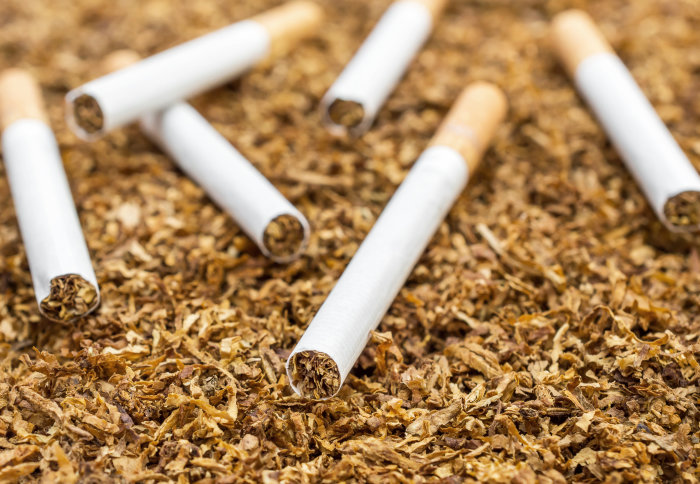Cigarettes have a significant impact on the environment, not just health

A new report shows that the six trillion cigarettes produced yearly impact the environment through climate change, water and land use, and toxicity.
The devastating impact of the tobacco industry on human health is well known. However, a new report systematically outlines for the first time the substantial impact of the tobacco industry on the environment.
The report, authored by scientists from Imperial College London, is launched today at a meeting of the World Health Organisation Framework Convention on Tobacco Control.
Finite resources
These impacts include climate change from energy and fuel consumption, water and soil depletion, and acidification. The global cultivation of tobacco requires substantial land use, water consumption, pesticides and labour – all finite resources that might be put to better use.
Smokers in the developed world are literally and metaphorically burning the resources of poorer countries. Dr Nicholas Hopkinson National Heart & Lung Institute, Imperial College London
Globally, the cultivation of 32.4 Million tonnes (Mt) of green tobacco, used for the production of 6.48 Mt of dry tobacco in the six trillion cigarettes manufactured worldwide in 2014, contributes almost 84 Mt CO2 emissions to climate change – approximately 0.2% of the global total.
Professor Nick Voulvoulis, from the Centre for Environmental Policy at Imperial, said: “The environmental impacts of cigarette smoking, from cradle to grave, add significant pressures to the planet’s increasingly scarce resources and fragile ecosystems. Tobacco reduces our quality of life as it competes for resources with commodities valuable to livelihoods and development across the world.”
Energy intensive production
‘Processing’ – the curing of tobacco leaves to produce dry tobacco – is highly energy intensive, using coal or wood burning that contributes to greenhouse gas emissions and deforestation. Tobacco production also uses more than 22 billion tonnes of water.
The transport and manufacture of cigarettes, as well as their final use and disposal, also use more resources and leave further waste.
The world’s top cigarette consuming country – China – harvests over 3 Mt of tobacco leaves using over 1.5 million hectares of arable land and significant fresh water resources – while habitats suffer from water scarcity and nearly 134 million of its people are undernourished.
Crop yields
The report compares the impact of tobacco against other crops that typically require fewer inputs. Moreover, the yield of these crops is in many cases considerably higher than that of tobacco. For example, in Zimbabwe a hectare of land could produce 19 times more potatoes than the 1–1.2 tonnes of tobacco currently cultivated.
The evidence also suggests that growing alternative crops is better for farmers and their families, as child labour remains a major issue in tobacco production.
Almost 90% of all tobacco production is concentrated in the developing world – of the top ten tobacco producing countries, nine are developing and four are low-income food-deficit countries (LIFDCs), including India, Zimbabwe, Pakistan, and Malawi. However, the majority of cigarette consumption takes place in the developed world.
Dr Nicholas Hopkinson, from the National Heart and Lung Institute at Imperial, said: “Smokers in the developed world are literally and metaphorically burning the resources of poorer countries.”
A lifelong impact
The report also calculates the environmental impact of a single smoker over their lifetime: a person smoking a pack of 20 cigarettes per day for 50 years is responsible for 1.4 million litres of water depletion.
The report calls for a range of actions to address these issues. These include strengthening the global evidence base so that gaps in the current environmental data can be filled, encouraging sustainable investment as well as making sure that the environmental cost of tobacco is included in the price, and encouraging the industry to take responsibility for the whole life cycle of its products.
The report is based on a scientific analysis published in the journal Environmental Science and Technology.
Chart caption:
The chart above depicts tobacco's global footprint across the entire supply chain, drawing on statistics from 2014.
The graphic shows that:
- 22,200 megatons of water, 5.3 million hectares of land, 62.2 petajoules of energy and 27.2 megatons of material resources went into creating 6 trillion cigarettes
- The cigarettes were manufactured in nearly 500 factories across 125 countries, and produced 6.48 megatons of dry tobacco, and 32.4 megatons of green tobacco leaf
- All of this produced 25 megatons of solid waste, 55 magatons of waste water, and 84 megatons of C02 emissions
Article text (excluding photos or graphics) © Imperial College London.
Photos and graphics subject to third party copyright used with permission or © Imperial College London.
Reporter
Hayley Dunning
Communications Division
Joanna Wilson
Communications Division